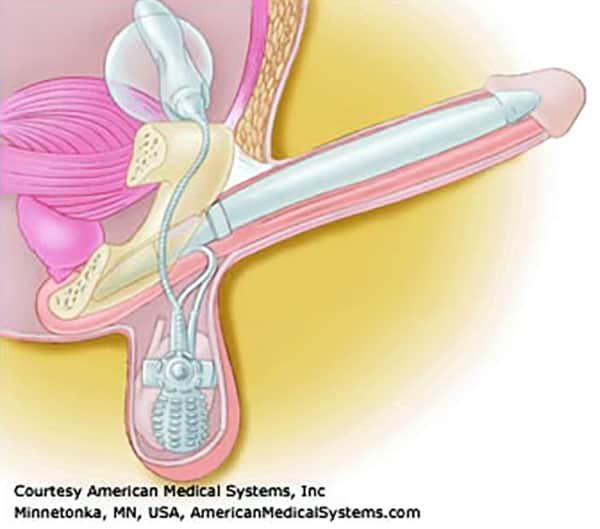What does the procedure involve?
Insertion of implants (prostheses) into your penis to allow erections for sexual intercourse. The entire device is implanted into the body and is not otherwise visible. Penile prostheses are usually reserved for patients who failed to respond to other medical treatments. They may also be used in patients with other conditions in which erections have been affected e.g. priapism (prolonged, painful erections) or Peyronie’s disease.
What are the alternatives to this procedure?
Although surgery is reserved for patients who have exhausted other treatments, you should discuss the merits of any treatment you have not tried with your surgeon. You may not be suitable for certain treatments, as a result of specific medical factors.
What should I expect before the procedure?
You will normally some baseline investigations before the procedure including a urine test to exclude a UTI, 5-7 days before your operation. If you have a urine infection or any other source of infection like a skin boil near the site of surgery, your operation will be delayed until the infection has been treated.
You will usually be admitted to hospital on the same day as your surgery.
You will be asked not to eat and drink for six hours before surgery. Immediately before the operation, the anaesthetist may give you a pre-medication, which will make you dry-mouthed and pleasantly sleepy.
Please tell your surgeon (before your surgery) if you have any of the following:
- An artificial heart valve.
- A coronary artery stent.
- A heart pacemaker or defibrillator.
- An artificial joint.
- An artificial blood-vessel graft.
- A neurosurgical shunt.
- Any other implanted foreign body.
- A regular prescription for a blood thinner e.g. Warfarin, Coumadin Xarelto®, Pradaxa®, Clopidogrel (Plavix®), Brilinta®, or Aspirin.
- Previous or current infection with an antibiotic resistant organism such as MRSA, VRE, etc.
What happens during the procedure?

Either a full general anaesthetic (where you are asleep) or a spinal anaesthetic (where you are unable to feel anything from the waist down) will be used. All methods reduce the level of pain afterwards. Your anaesthetist will explain the pros and cons of each type of anaesthetic to you. The implant may be either bendy (malleable) or inflatable (pictured); the latter requires a mechanical pump. Not all patients are suitable for both types but this will have been discussed in detail with you before the procedure. An incision is usually made at the junction of the penis and scrotum to insert the implants. The surgeon may make a second incision to put in the balloon reservoir into the abdomen. Although this put in through the first incision, your surgeon may feel is safer to do this through a separate incision, especially if you have had previous abdominal surgery.
What happens immediately after the procedure?
If an inflatable prosthesis has been implanted, we leave it in the inflated position overnight to reduce bleeding but it will be deflated before you go home. You may experience discomfort for a few days but painkillers will be provided for you to take home. Absorbable stitches are normally used which do not require removal. A catheter may be inserted into the bladder for 24 to 48 hours after the operation, to prevent any problem with passing urine. Once the catheter has been removed, and you are passing urine normally, you will be able to go home. Some surgeons use a tube drain temporarily (overnight) to prevent collection of blood at the operation site. The average hospital stay is one day after surgery. You will be asked not to inflate the prosthesis until an outpatient appointment at 2-3 weeks. At that stage, we will teach you to inflate and deflate it (this is known as “cycling” the prosthesis). It is not advisable to have sex for at least six weeks after the operation.
Are there any side-effects?
Most procedures have possible side-effects. But, although the complications listed below are well recognised, most patients do not suffer any problems.
Common (greater than 1 in 10)
- Temporary swelling and bruising of the penis lasting several days.
Occasional (between 1 in 10 and 1 in 50)
- Significant bleeding or infection needing further treatment (including removal of all or part of the prosthesis in 2 to 3%).
- Nerve injury with temporary or permanent numbness of the head of the penis.
- Drooping of the glans penis needing correction.
- Mechanical failure needing revision at a later stage; his may involve replacement of all or part of the device and can happen at any stage, from a few month to several years later.
- Self-inflation due to mechanical failure.
Rare (less than 1 in 50)
- Injury to the bowel or bladder during insertion of the balloon component within the abdomen.
- Erosion of the prosthesis where a part of the device may break out of its normal position and appear at another site.
What should I expect when I get home?
You will get swelling of the penis and scrotum after a few days, which may last up to 10 days but will then subside. Do not be alarmed because it is expected.
WHAT ELSE SHOULD I LOOK OUT FOR?
If you develop a temperature, increased redness, throbbing or drainage at the site of the operation, please contact your surgeon.
Q&A Penile Implant Surgery
Disclaimer
This information is intended as a general educational guide and may not apply to your situation. You must not rely on this information as an alternative to consultation with your urologist or other health professional.
Not all potential complications are listed, and you must talk to your urologist about the complications specific to your situation.
